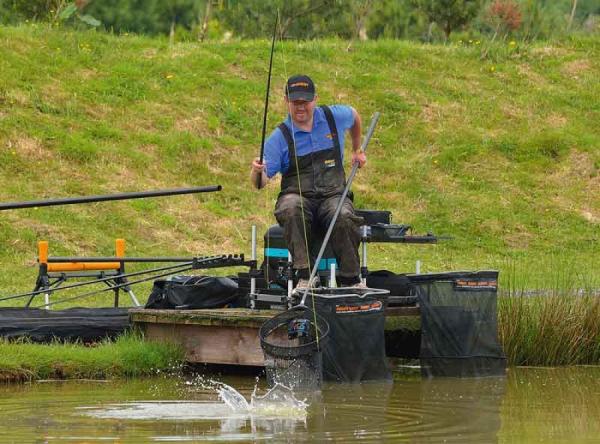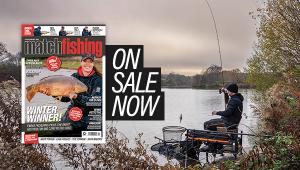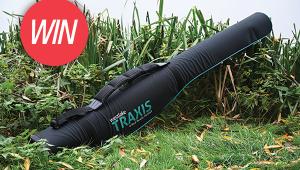Stuck In The Mud!

Middy-backed matchman Kieron Rich reveals his against-the-grain tactics for tackling ‘The Mud Line’…
The warmer the weather, the more inclined carp are to investigate the very shallowest areas of lakes. If you have ever fished or walked around a fairly clear lake you will often observe carp lying in shallow water in the margins. You will also see them colouring up the water as they root around for food items.
In a match, the far banks and islands of lakes become very favourable areas to target, as the pressure and disturbance from anglers around the lakes pushes the fish out to these features and cover.
What Is The Mud Line?
This line or area of the peg that we’re talking about fishing, known as the mud line, is basically the very shallowest area of the swim tight against some mud on the far bank. When faced with an island, you often find that the shallowest part of the lake is where you can see mud on the far bank, hence why this style of fishing gets its name.
When To Fish The Mud Line?
The best rule I was ever taught about fishing states: “Always fish where the fish want to be.” It sounds straightforward enough, but surprisingly many anglers, particularly newcomers, fail to catch due to not observing this simple guideline.
Therefore, when it is appropriate to fish the mud line to tempt fish, that is exactly where I will fish. You can often tell when the fish want to be in the mud line as you get lots of liners, missed bites and foul-hooked fish when you fish anywhere other than tight across in this shallowest water possible. They simply push bait further and further up the slope when competing for food, meaning the most effective way to catch them is to target very shallow water right up against the mud.
In a match, the mud line may be just an option to be visited as part of an overall plan, but if it proves to be the most productive line then of course it could rapidly turn into the main line of attack.

Holding a tight line as you push the rig against the mud keeps your rig tight, meaning you miss very few bites from F1s.
Time Saver
If I’m in a match, then I need to decide if shipping to full length, say 13 metres or more, is going to bring me more fish than fishing shorter. Only trial and error can ever influence that decision, and ultimately the choice is down to the angler. Often, I’ll spend the first 90 minutes of the session trying to figure out what is the most efficient way to build up a weight. I’m then left with the latter half of the match to fish efficiently.
Try and gauge what stamp of fish you’re catching in different areas of the swim, and gauge how fast you’re getting bites. If you’re catching smaller fish on the mud line than on the short pole, but getting bites much quicker, I’d be inclined to fish there. Often, the activity of lots of feeding fish in the swim will attract bigger fish later anyway.
Plumbing Up
A plummet is obviously essential to ascertain the contours and depths so that rigs can be set perfectly. There are limits in terms of fishable depths, but it is very possible to catch fish in as little as six inches of water. Generally, you find that a mud line is anything from 15 to 10 inches deep – this is the perfect depth range. Today, however, I have two rigs sorted: one set around a foot deep, and one to fish a bit deeper at around two to two-and-a-half feet deep. The deeper rig isn’t on the mud line, but it will give me indications of when to fish there, and also give me an area of the swim to target when bites dry up tight to the mud.
I’ll probably begin on the deeper rig and pick off whatever is there first, as this gives me somewhere to go after – ie tight up to the bank in the very shallow area, which I’d say is what we would call the real mud line.
Tackle
There aren’t any significant snags here, so I am going to use Middy Lo-Viz line in 0.12mm diameter straight through on my rig. This has a breaking strain of 3.2lb, which should cope with anything that swims here in Covey Six, at Partridge Lakes Fishery, but of course if your own venue has much larger carp in it then you will need to step up accordingly. Fishing light definitely gets you more bites, in my opinion.
Float choice is a 4x10 Middy Styrex One. These exceptionally robust little floats lend themselves to this kind of work. They incorporate a reinforced side eye, which helps to guard against getting caught in reeds or weed, and the antenna is hi-viz and quite thick to make it very easy to spot on the far side.
I will be using maggots today, and the hook I have chosen is the KM-4 in a size 18. It has a wide gape and is not named Carp X-Strong for nothing! It’s a very tough hook pattern, with an exceptionally durable point on it.

A fine, but strong hook choice.
Elastic Matters…
Today I am using the yellow 6-10 strength Middy Hi-Viz Shock Core elastic, and I have to say it’s an impressive all-rounder that copes really well with small to medium-sized fish. I love using these soft hollow elastics in conjunction with a side Pulla Kit and gripper bead. The soft elastic means that fish will swim straight out of the swim with little disturbance – vital when fishing in shallow water on the mud line.

Interestingly, Kieron fishes with his Dacron in a loop on his elastic, with the bead covering the knot.
When it comes to landing the fish, I can control them easily and efficiently by stripping out the elastic to tension it. To further alleviate the risk of tangles when shipping out on a long pole, the line is attached to the elastic via a Dacron connector. It is these small aspects that make for smooth and efficient fishing on the mud line.
Maggot Mania
The nitty-gritty of this mud-line approach in summer revolves around taking advantage of the basic feeding behaviour of carp, and F1s. I would suggest that instinctive greed is what we are exploiting here. It is for this reason that I choose to use maggots – all species of fish eat maggots, and once silver fish and other species home in on the maggot feed, the carp will soon follow.
I’ll start by introducing a decent pot of maggots and that is to draw in the carp quickly to compete. I will also fire loose maggots over the top using a catapult, approximately half a dozen to a dozen depending on response, and this should tempt the carp to rise up to greedily intercept more bait, including my double maggot hook bait.
Double maggot will stand out as a ‘meatier’ morsel thanks to the rest of the feed, and usually tempts a larger stamp of fish. I do expect to catch ide, barbel, tench and roach as well, but the large deposit of maggots via the cup will draw the carp because they are bullies and will greedily edge the other species out of the way.
I like to keep putting fish in the net too, and the extra weight from silvers that I’ve caught in-between carp has won me loads of matches over the years!

Kieron feeds with a large cup of maggots at the start of a session, and when the swim dies.
Presentation
My shotting incorporates small No10 shot spread out evenly to allow a natural slow fall rate of the hook bait to mimic the loose feed. I’ll feed with the pot typically once every 10 to 15 minutes, and fire loose maggots across every couple of minutes.
Another important element to success on the mud line lies in the fact that I’ll lift the rig out every 30 seconds in order to reintroduce it, so that the falling hook bait will be hard to resist to the greedy carp. Hopefully, you can now understand how the feeding is indeed linked to the shotting pattern. It’s a simple, but highly effective strategy.
This really is where my thoughts on mud-line fishing differ from those of other anglers. Most people fish with heavy floats and bulked down rigs, and push the rig tight into the bank over a small area of feed that has been accurately potted in. However, I much prefer to feed aggressively with a combo of pot and catapult, to constantly draw in fish, and get them competing. I can then catch them through the water on the drop, and also once the rig settles on the bottom too.
I like to present the rig by laying the rig out on the water, and then push it tight in as close to the mud as possible, keeping a tight line between float and pole tip all the time. This way, the bait falls into the swim and on to the far bank slope naturally, and once settled the rig is tight between the pole tip and hook bait, meaning every bite virtually pulls the elastic out!
Top Tip!
A good tip is to try and feed the swim with the catapult when you are playing a fish, especially one that is fighting well and taking some time to land. This will prime the swim for when you get back across to it after landing the hooked fish.

Small Tricks
I tend to fish with the bait set at dead depth and I will mark that depth on the pole top kit to act as an indicator.
By dead depth, I mean plumbing up accurately so that just the bristle of the float is out when the plummet is in the position I’ll be fishing. If you have too much or too little amount of line on the bottom, I find that you miss a lot of bites, and foul hook fish.
Work It!
Working the mud line can also require fishing along the edge of the far bank available to you, so it makes perfect sense to bait more than one spot where possible. Often, there are two or three areas of mud available for you to fish against on the far bank. Don’t be afraid to bait up and feed all three, and rotate between them to keep fish coming for a more prolonged period. This is really effective on tricky days, when the disturbance of hooking a fish in the shallow water means you have to wait for a bite next time you ship out. A great trick is to catch a fish from one mud line, then move to the other.
To justify fishing such a long pole line requires that a fish has to be caught pretty much every time you ship out, if at all possible, so by having more than one spot to try you should be able to tempt something every drop in.

Don’t be afraid to feed two or three areas against different parts of mud on the far bank, and hop between swims to keep fish coming.
The Session
Today’s session has gone to plan on an ideal day with lovely warm and still conditions. I’ve ended up with a cracking bag of mainly carp and F1s as anticipated.
Ultimately, choosing to fish the mud line or not boils down to deciding if it will be the spot within your peg that is most likely to produce the most fish, and only you can make the decision having assessed the prevailing conditions. For example, a windy day may scupper your presentation fishing very long on the pole, in which circumstances you need to fish closer in where you can feed and present a bait better.
As with all approaches, fishing the mud line is another string to your bow when fishing matches on commercials. Hopefully my slightly different take on the approach compared to other anglers, will help you win more matches.

Proof that doing things differently from the crowd can be deadly!
Angler File
Kieron Rich
Age: 40
Lives: Manchester
Sponsor: Middy
MF Says: A mud-line maniac!
Venue File
Partridge Lakes Fishery
Location: Glaziers Lane, Warrington WA3 4AQ
Contact: 07469 981743
Web: partridgelakes.co.uk
Like what you see?
Or buy a single issue
- Log in or register to post comments









